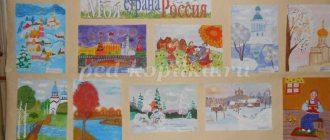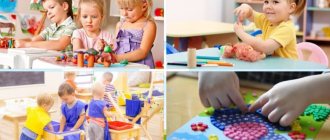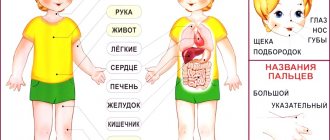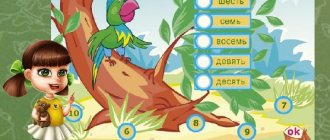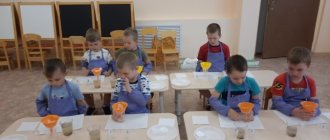Games for preschool children. Functions, components, types
Consultation for teachers of preschool educational institutions “Game as an important form in the development of children”
Preschool age is the period of a child’s familiarization with the knowledge of the world around him, the period of his initial socialization. The high sensitivity of preschool children and easy learning, thanks to the plasticity of the nervous system, create favorable opportunities for successful moral education and social development of the individual. During these years, the child acquires initial knowledge about the life around him, he begins to form a certain attitude towards people, towards work, develops skills and habits of correct behavior, and develops a character. This explains the enormous educational potential of play, which psychologists consider the leading activity of a preschooler. Play is the leading type of activity, the most effective form of child development. The game lays the foundations of a future personality. By playing together, children begin to build their relationships, learn to communicate, not always smoothly and peacefully, but this is the path of learning, there is no other way. In addition, in the process of playing together with peers, the child develops the most important communicative qualities he needs in the field of communication and interpersonal interaction. It is generally accepted that play is an imaginary or conditional activity, purposefully organized among children for their relaxation, entertainment and learning. A game is not entertainment, but a special method of involving children in creative activities, a method of stimulating their activity. Therefore, it is necessary to take a detailed look at the resources of children’s play and study the conditions that allow it to have the most effective impact on successful development. Childhood without play and outside of play is not normal. Depriving a child of play practice is depriving him of his main source of development: the impulses of creativity, the signs and signs of social practice, the richness and microclimate of collective relationships, and the activation of the process of learning about the world. According to psychologists, it is in play that a child builds his first models of the world around him, learns the rules of communication between people, and develops his abilities and character. Play is the only central activity of a child, taking place at all times and among all peoples, where active imagination occurs, under the influence of which existing knowledge is combined, real, real ideas are combined with fiction and fantasy. By playing together, children begin to build their relationships, learn to communicate, not always smoothly and peacefully, but this is a learning path. Formation of gender, family, citizenship, patriotic feelings, a sense of belonging to the world community. The most effective form of socialization of a child, where the foundations of a future personality are laid. A child’s play performs the following functions: 1. Socialization function. Play is the strongest means of including a child in the system of social and interpersonal relations, of assimilating the riches of culture. 2. Function of interethnic communication. The game allows the child to assimilate universal human values, the culture of different nationalities, since “games are national and at the same time international, interethnic, universal.” 3. The function of a child’s self-realization in the game as a “testing ground for human practice.” The game allows, on the one hand, to build and test a project for relieving specific life difficulties in the child’s practice, and on the other hand, to identify the shortcomings of experience. 4. The communicative function of the game - (mastering interaction skills) clearly illustrates the fact that the game implements communicative activity, allowing the child to enter the real context of complex human communications. 5. The diagnostic function of the game - (identification of individual and personal characteristics of children, self-knowledge during the game) provides an opportunity for the teacher to recognize and record various manifestations of the child (intellectual, creative, emotional, etc.). At the same time, the game is a “field of self-expression” in which the child tests his strength, capabilities in free actions, expresses himself and asserts himself. 6. The play-therapeutic function of the game is to use the game as a means of overcoming various difficulties that arise in the child’s behavior, communication, and learning. 7. Correction function - involves making positive changes and additions to the structure of the child’s personal indicators. In the game this process occurs naturally, gently. 8. Entertaining - aimed at achieving pleasure and awakening interest, inspiration. Main components of the game The game includes: 1. game state (motive), 2. game positions, 3. game situations, 4. game roles and actions, 5. game result. For children, the result of the game, victory, success is not always important. They like the process itself, those roles, those relationships that change the child’s status in the team. Types of games Yard games (street) “Hide and Seek”, “Tag”, “Burners”, “Cossacks-Robbers”, etc. Gathering games Blind man’s buff, verbal, kissing. “I was born a gardener. ”, “Ring, ring”, “Broken telephone”, etc. Round dance games (these are folk games, the movement of people in a circle with singing and some kind of dance, game) Game “Stream”, “Wattle fence”, “Dawn” Dance games (the dance dominates, and the game is its decorative detail) “Flower Bazaar”, “Three Circles” Educational games “The Wise Raven” Quiz is a game of answering questions, usually united by some theme Lottery (raffling of any items for tickets) This maybe: “Search” lottery, “Your chair is your luck”, “Dance”. Game - song You need to sing any song Games - five minutes Any finger games Communication games
Games of this type perform a diagnostic, correctional, psychotherapeutic role.
The main condition of these games is goodwill and game dialogue. - “Interview” - “Compliment” Dating games
- “Snowball” - “Tell about yourself in three words” - “Ball in a circle” - “Hello!
» Competitive games
are a competition aimed at highlighting the best participants - “Find out the song” - “Cinderella” Scrabble – games “Battleship”, “Intellectual Hockey”, “55”, “Burglar”
Games - jokes
- “Wild Monkey” - “ Camel" Game is a product of activity through which a person transforms reality and changes the world. The essence of the game is the ability to reflect and transform reality. In play, the child’s need to influence the world is first formed and manifested - this is the main, central and most general meaning of the game. It helps psychological relaxation and harmonious entry into the world of human relationships. The game is especially important for children who learn about the surrounding reality through reproducing the actions of adults and the relationships between them in the game process. Play is essential for the physical, mental and moral education of children.
Classification of games:
By area of activity: - physical - intellectual - labor - social - psychological By the nature of the pedagogical process - educational - training - cognitive - developing - educational - productive - reproductive - creative - communicative - diagnostic By game methodology - subject - plot - role-playing - business By gaming environment - without objects - with objects - tabletop - room - street (yard) - on the ground - technical By subject area - mathematical - biological - musical - literary - theatrical - sports - labor - folk - economic and other Games Preschool children are very diverse. Traditionally, games are distinguished between mobile games, role-playing games, board games and didactic games. 1. Outdoor games. They are very good for health. A growing child's body cannot sit in one place for a long time; it needs movement, the release of accumulated energy. And outdoor games are an indispensable way of this energy release and the development of physical qualities of younger schoolchildren. In many, there is a fight for individual or team championship. In addition to physical qualities, they develop such personality traits as courage, endurance, and perseverance. 2. Role-playing games. They reflect phenomena and processes that children observe or hear about from the adult world. In these games, each child takes on a specific role, for example, a doctor, a teacher, a fireman, and depicts the corresponding activity. Sometimes the plot of a game is planned in advance, events and actions unfold in a certain way (story games). 3. Board games. Some of them are very useful for expanding cognitive interests and for mental development. Such games include lotto with pictures, word games with all kinds of riddles, charades, rebuses, puzzle games, etc. 4. Didactic game. This is an active educational activity on simulation modeling of the systems, phenomena, and processes being studied. Since preschoolers love to play, the process of transferring a system of knowledge, skills and abilities in the form of a game is the most effective. These types of games help the child better understand the educational material. In addition, they promote active interaction between the participants in these games. The game allows the child to obtain and generalize knowledge about the world around him, develop his sense of collectivism, the desire and ability to help others. Play is the strongest means of including a child in the system of relations of the society to which he belongs, of assimilating cultural and spiritual riches. In the game, intellectual, personal qualities and physical abilities develop. Regular joint games will enrich preschoolers with new impressions, will contribute to the formation of social competence skills, and will give them new social experience, which is so important for the development of their personality. For the social development of preschoolers, not only play is of great importance. Classes, conversations, exercises, getting to know music, reading books, observing, discussing various situations, encouraging mutual assistance and cooperation of children, their moral actions - all this becomes the building blocks that make up a person’s personality. A child perceives beauty very deeply - which means he needs to be introduced to the best human creations, shown reproductions of paintings, or visit an exhibition, museum, or gallery with him. You should prepare for such a trip, because the child will definitely ask many questions that the adult will have to answer. Social development is no less necessary for the individual than the development of intellectual, creative, and physical abilities. The modern world is structured in such a way that one of the conditions for success is the ability to work fruitfully in a team, to find ways to interact and understand each other with the people with whom you work. And, of course, your child’s mental comfort and emotional satisfaction will directly depend on how his relationships with other people will develop, what role he will play in the team in which he will be, and who he feels like. And our task is to correctly and skillfully help him acquire social skills. Thus, we can conclude that such an organization of the educational process with children contributes to the social and personal development of each child. Children become more liberated and independent, purposeful and self-confident, sociable, more attentive and caring towards peers and adults; capable of mutual understanding and cooperation. Children develop the ability to jointly make decisions and follow their implementation.
We recommend watching:
Didactic sensory game for kindergarten Fun games for the middle group Game for kindergarten “Family chores” Didactic games for preschoolers 3 - 5 years old
Similar articles:
Educational games for preschool and primary school children
Games in kindergarten for children from 3 to 5 years old
Thematic role-playing game “Hospital” for older preschoolers
Role-playing game for preschoolers 5-7 years old
Story-based didactic game for older preschoolers “We are traveling on a train”
Functions of the game in the pedagogical process of preschool educational institutions
Since play contributes to the development of the child and is a complex process focused on achieving socially significant goals, its functional role in preschool education and upbringing is enormous.
The game performs the following functions:
- Educational function. Through play, children develop speech, memory, sensation and perception, and their mental processes are activated;
- Entertainment function. The game allows children to relax and not feel stress during learning and other activities. it carries positive emotions, captivates the child, thereby developing his cognitive interest;
- Communication function. It is in play activities that contacts are established between children, between a child and an adult. The game teaches the formation of social connections, building communication and interaction between people;
- Psychotechnical function. The game acts as a stage in preparing the child for other activities, helping to rebuild mental processes and prepare them for more intense activities;
- Function of self-realization. The game helps the child to reveal himself, his natural inclinations, to express himself;
- Compensatory function. The game creates an environment that makes it easy to satisfy the child’s needs and interests, his desires, which in reality may not be feasible or very difficult to fulfill.




